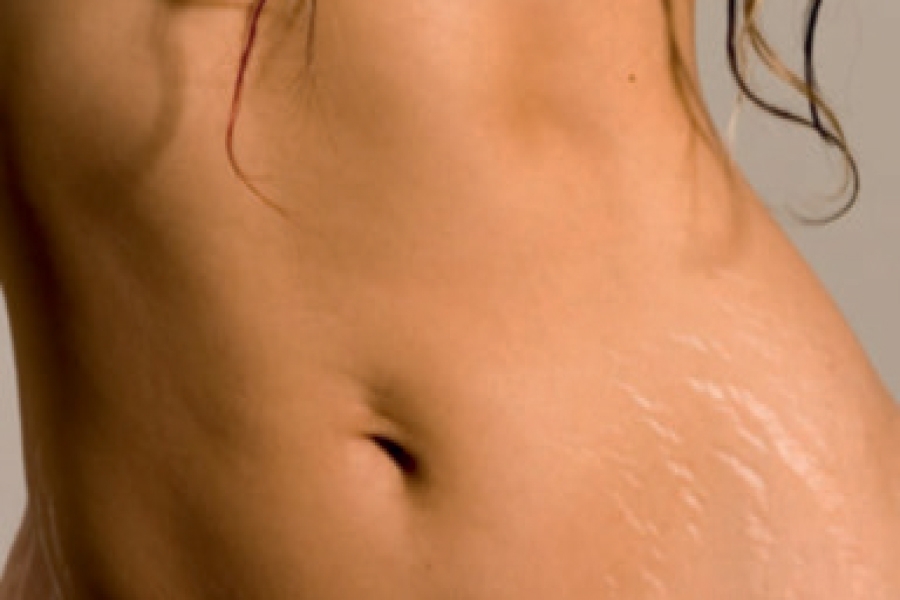WHAT ARE STRETCH MARKS AND WHY DO WE GET THEM?
Literally, the skin is being stretched, and the dermis (layer of skin in between the top layer epidermis and the fat) is being torn. When you look at samples of striae under the microscope you find thinning of the epidermis, blood vessel changes, and reduced collagen fibers and a decrease in elastic fibers, which usually allow the skin to stretch. We get stretch marks whenever our skin is rapidly stretched such as during growth spurts in adolescence, rapid weight gain, or in pregnancy. In fact up to 90% of women get stretch marks during pregnancy so this affects us all. Things that make you at higher risk for getting stretch marks during pregnancy include maternal weight at baseline, weight gain during pregnancy, increased abdominal and hip girth, vitamin C level, as well as increased gestational age at delivery, birthweight, and head circumference of the baby. You also see stretch marks in patients who take steroids chronically, because steroids reduce the skin’s ability to stretch and make elastic fibers.
There are two types of stretch marks. When they first appear, stretch marks (striae rubra) are pink to purple, asymptomatic or slightly itchy, and puffy. Over years, these turn into white wrinkled thinned older stretch marks (striae albae). The distinction is more important in terms of treatment below.
PREVENTION
Topicals
A review paper looked at 11 studies and evaluated the level of evidence supporting various therapies for prevention of stretch marks. Topical therapies claim to work by increasing collagen synthesis, decrease inflammation, and increase elasticity and rehydration of the skin. They found that Trofolastin and Alphastria (hyaluronic acid, vitamin A and E) creams may have some benefit, retinoids have varying effects depending on which study is examined (category C drug, not for use during pregnancy and lactation), and cocoa butter and olive oil have no effects. Another paper reviewing other studies found limited evidence for centella (a medicinal herb) and massage with almond oil, weak evidence for hyaluronic acid, and again, no evidence for cocoa butter and olive oil.
Diet and exercise
Since increased weight gain and abdominal girth may be associated with stretch mark development, some doctors believe that eating a healthy diet and engaging in regular exercise can be helpful. There is sadly no published evidence showing that lifestyle modifications have clinically significant outcomes for stretch marks, but I personally believe that a healthy diet and exercise is useful anyways for people regardless of pregnancy status, so I would keep this in mind if I were to become pregnant in the future.
Treatment
Treatments include microdermabrasion, microneedling therapy, platelet rich plasma therapy, intense pulsed light therapy, and, last but not least, laser therapy. Laser therapies have become more popular for treatment of stretch marks recently due to their ability to normalize the color and even the architecture of the treated skin. Pulse dye laser is a popular laser we often use in dermatology to treat vascular lesions such as port wine stains or cherry angiomas, and they can be used for striae rubra which are, as the name implies, red. One of our attendings Dr. Geronemus , in conjunction with Dr. Hale, published an article looking at fractional photothermolysis on striae, and found it to be effective especially in striae rubra. Striae albae, which are white stretch marks, remain challenging to treat. One paper concluded that nanofractional radiofrequency therapy is effective for striae alba, and other review papers suggest that radiofrequency in combination with other treatment modalities such as microneedling or platelet rich plasma therapy can be useful. In the end, it is somewhat difficult to compare the efficacy of all the lasers because each paper uses different protocols, laser settings, and number of treatments.
WHAT DO I THINK?
Sadly there is a lack of great scientific data out there regarding both prevention and treatment of stretch marks, though I will say I was impressed by the recent increase in laser studies on striae rubra and striae albae. In terms of prevention, I would advise my pregnant friends to consider lifestyle modifications to maintain a healthy weight with diet and exercise (good for anyone’s health in general, so why not) and to consider frequent emollient use. If stretch marks develop, I would advise treatment while the marks are still red (striae rubra) since these are much more amenable to therapy with lasers. If the stretch marks are white and atrophic (striae albae), I would still see a dermatologist to consider fractional laser treatment or radiofrequency therapy in conjunction with other modalities if your dermatologist offers it. As time goes on, I’m sure that we will have more and more data that will help us make our therapeutic decisions!
As usual, my caveat here is that while scientific evidence is lacking, if you have found something that works really well for you personally, then keep using it as long as it does not cause your body harm.
I hope this was a useful blogpost for you; feel free to leave questions and comments below! What has been useful for you, in your experience?
